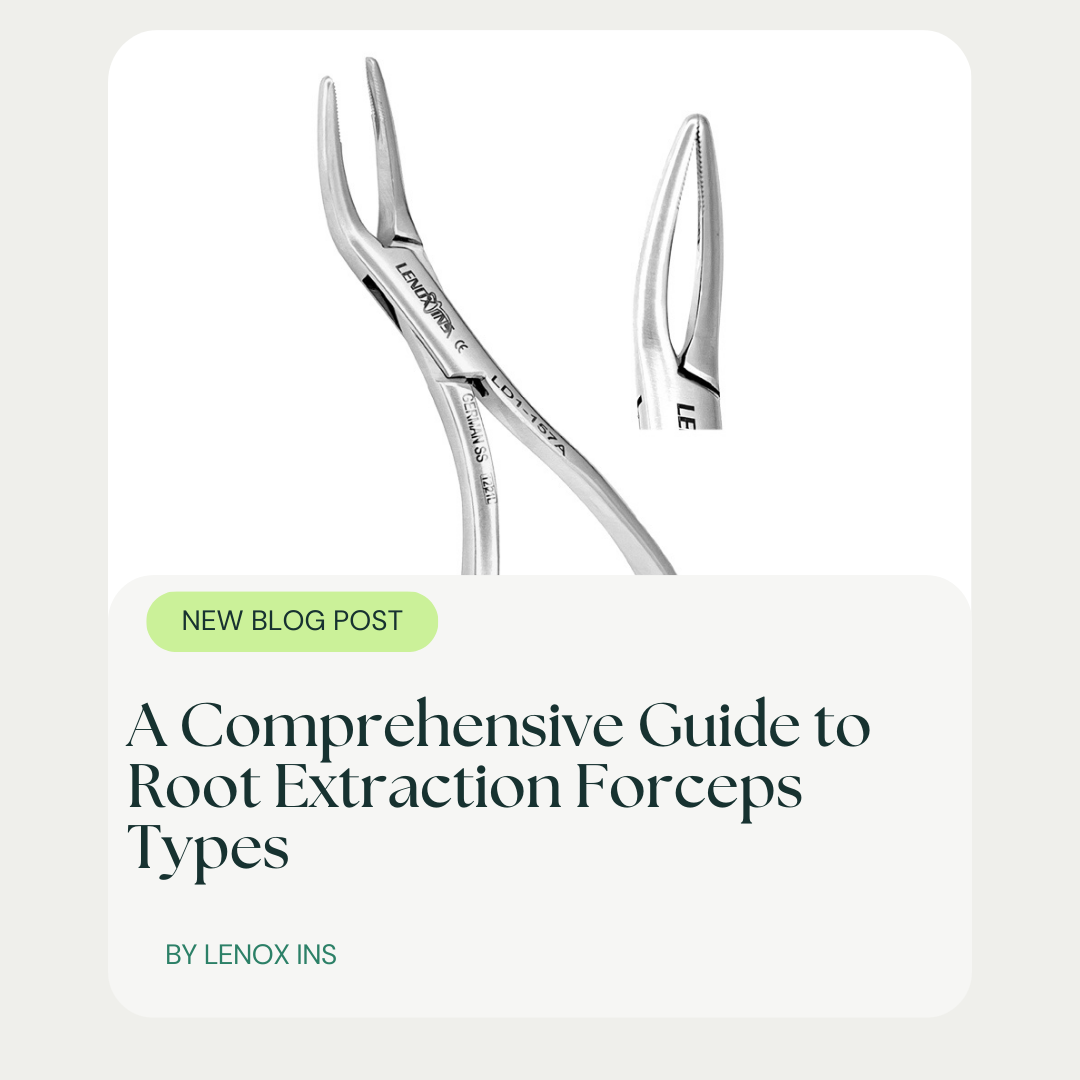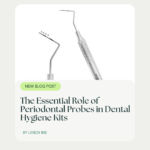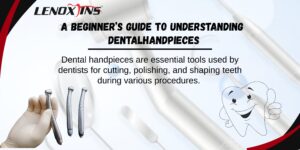Ultimate Guide to Wisdom Teeth Removal Forceps
- lenoxinstro
- October 16, 2024
- Dental Forceps, Dental Surgical

Choosing the right extraction forceps can significantly impact the effectiveness of wisdom teeth removal. Many dental professionals face challenges, such as avoiding damage to the inferior alveolar nerve or ensuring minimal bacteria exposure during the procedure. This article will explore various types of extraction forceps, key factors to consider when selecting the right tool, and best practices for usage. By understanding these aspects, readers will be better equipped to enhance outcomes and ensure a smoother extraction process for patients, ultimately improving their skills in managing complex cases involving the maxilla and mandible.
Key Takeaways
- Understanding tooth positioning is crucial for selecting the right extraction forceps
- Specialized forceps are essential for effectively managing impacted wisdom teeth
- Proper grip techniques can minimize trauma during the extraction process
- Post-extraction care of instruments is vital for safety and hygiene
- Ongoing training improves practitioner skills and overall extraction outcomes
Understanding the Role of Extraction Forceps in Wisdom Teeth Removal

Wisdom teeth extraction presents unique challenges, from their positioning to potential complications. extraction forceps play a crucial role in effective removals, aiding practitioners in managing these complexities. This section will explore the foundational differences between standard and wisdom teeth forceps, as well as the importance of antibiotic prophylaxis and maintaining oral hygiene pre- and post-extraction to minimize risk, especially for patients on anticoagulants.
The Unique Challenges of Wisdom Teeth Extraction
Wisdom teeth extraction is often complicated by the unique positioning of these teeth, which can grow at angles, become impacted, or develop cysts. Factors such as the patient‘s age, the presence of permanent teeth, or pre-existing conditions like thrombus can increase the complexity of the procedure. Practitioners must use appropriate dental anesthesia to ensure patient comfort and employ disinfectants effectively to reduce infection risk during and after the extraction.
- Wisdom teeth may be angled or impacted.
- Patient age and conditions like thrombus play a role.
- Dental anesthesia is crucial for comfort.
- Disinfectants are necessary to minimize infection risk.
How Forceps Aid in Effective Extractions
Extraction forceps are essential tools in the process of wisdom teeth removal, allowing the surgeon to grasp and manipulate the tooth effectively. These specialized instruments provide better access to areas that may be difficult to reach, especially when dealing with impacted teeth. By utilizing local anesthetic in combination with the forceps, practitioners can ensure that patients remain comfortable, while the precise grip of the hand enables careful extraction that minimizes trauma to surrounding tissues, thereby reducing the need for additional procedures like bone grafting or excess use of cement for stabilization.
| Aspect | Details |
|---|---|
| Tool | Extraction forceps designed specifically for wisdom teeth. |
| Technique | Proper grip technique ensures minimal trauma. |
| Anesthetic | Use of local anesthetic enhances patient comfort. |
| Surgeon Skill | Experience and skill of the surgeon are critical for effective extraction. |
| Potential Additional Procedures | Consideration for bone grafting or cement use if needed. |
Differences Between Standard and Wisdom Teeth Forceps
The differences between standard and wisdom teeth forceps are critical for achieving successful outcomes in dental procedures. Wisdom teeth forceps often feature a bayonet design, which allows for improved access and angled pressure application during extraction. This design is especially beneficial for navigating complex pathology associated with impacted wisdom teeth, ensuring that the extraction process minimizes trauma and discomfort for the patient. These specialized instruments contribute significantly to the overall success of the procedure, reducing the likelihood of complications that may require the use of plaster or additional interventions post-extraction.
Extraction forceps are vital tools in the skilled hands of a dentist, making the removal process more efficient. Next, it is essential to explore the specific types of extraction forceps used for wisdom teeth, each designed for precision in a delicate procedure.
Types of Extraction Forceps for Wisdom Teeth

The selection of extraction forceps is pivotal for effective wisdom teeth removal. Maxillary third molar forceps are designed for upper teeth, allowing for better access to the paranasal sinuses and minimizing risk to the lingual nerve. Mandibular third molar forceps facilitate extraction of lower teeth, while right and left-specific forceps ensure precision. Additionally, universal forceps offer versatility in varying situations, complementing the use of instruments like curettes during the procedure.
Maxillary Third Molar Forceps
Maxillary third molar forceps are specifically designed to facilitate the extraction of upper wisdom teeth, known as maxillary molars. These forceps enable practitioners to grasp the crown of the tooth while applying controlled pressure to the surrounding ligament, minimizing trauma and optimizing hygiene throughout the procedure. The tapered design and precise tweezers-like grip of these instruments help in effectively removing teeth that may be impacted or decayed, addressing concerns related to tooth decay and ensuring a smoother extraction process.
- Designed for upper wisdom teeth extraction.
- Enhances grip on the crown of the tooth.
- Minimizes trauma to surrounding ligament.
- Optimizes hygiene during the procedure.
- Addresses issues related to tooth decay.
Mandibular Third Molar Forceps
Mandibular third molar forceps are specifically engineered to facilitate the extraction of lower wisdom teeth, making them an essential tool in dental practice. These stainless steel instruments often feature a lever mechanism that allows for precise movement and effective application of force, which helps to dislodge the tooth without unnecessary trauma to the surrounding tissues. Additionally, their design may incorporate a mallet or scissors action to further enhance control during the extraction process, providing dental professionals with the confidence to tackle challenging cases involving impacted or decayed teeth.
Right and Left-Specific Forceps
Right and left-specific forceps are essential tools for effectively extracting wisdom teeth while minimizing the risk of injury to the trigeminal nerve and surrounding structures. These forceps are designed to match the anatomical contours of the dental arch, allowing for a more precise grip on the tooth. By using a chisel-like movement during extraction, practitioners can reduce the strain on the lip and surrounding tissues, ensuring a smoother procedure that considers the patient’s comfort and the careful management of medication during recovery.
Universal Forceps and Their Uses
Universal forceps are versatile tools used in wisdom teeth removal surgeries. Their design allows practitioners to adapt the forceps for different angles and positions, which is particularly useful during procedures involving sedation. Additionally, these forceps can assist in managing complications that may arise, such as the need for bur adjustments or considerations for grafting post-extraction, ensuring the comfort of the patient’s tongue and surrounding tissues throughout the process.
| Category | Description |
|---|---|
| Tool Type | Universal forceps for various extraction scenarios. |
| Application | Useful in cases requiring angle adaptability during removal. |
| Patient Comfort | Designed to minimize trauma during sedation. |
| Procedure Complications | Aids in bur adjustments and potential grafting needs. |
Choosing the right extraction forceps is as crucial as knowing the types available. Understanding the factors that influence this choice will ensure the best outcome for wisdom tooth removal.
Factors to Consider When Choosing Forceps

When selecting the right extraction forceps for effective wisdom teeth removal, several factors must be considered. The positioning and angle of the tooth influence the choice of dental instrument, while the patient‘s oral anatomy is crucial in determining the appropriate forceps design. Additionally, the distinction between impacted and erupted wisdom teeth significantly impacts the extraction technique. Finally, the material and design of the forceps, along with the potential risk of complications such as osteonecrosis of the jaw, should guide practitioners in their selection process. Each of these factors plays a vital role in ensuring a successful extraction and minimizing post-operative complications, thereby providing valuable insights for restorative dentistry practices.
Tooth Position and Angle
The position and angle of the tooth within the mandible significantly influence the choice of forceps during wisdom teeth removal. Understanding the orientation of impacted wisdom teeth is crucial, as it affects the surgeon‘s approach and the degree of force required. For example, when a wisdom tooth is angled toward the adjacent nerve, practitioners often rely on specialized forceps designed for such challenging extractions, ensuring minimal trauma and effective anesthesia with agents like articaine to enhance patient comfort.
Patient's Oral Anatomy
The patient‘s oral anatomy plays a pivotal role in the selection of extraction forceps during wisdom teeth removal. Variations in the size and shape of molars, as well as the arrangement of the alveolar ridge, can influence how forceps grip and maneuver around the tooth. For instance, patients with a specific type of prosthesis may require careful consideration to prevent unnecessary stress on adjacent structures, while effective use of anesthetic ensures comfort throughout the procedure, reducing the risk of complications like alveolar osteitis after extraction.
Impacted vs. Erupted Wisdom Teeth
Understanding the distinction between impacted and erupted wisdom teeth is essential when choosing the right extraction forceps. Impacted wisdom teeth, which may be located close to the maxillary sinus or embedded in the periosteum, often require specialized forceps that can navigate their orientation and depth effectively. In contrast, erupted wisdom teeth may necessitate standard extraction techniques, where the focus is on utilizing local anesthesia to ensure patient comfort during the healing process following extraction.
| Type of Wisdom Tooth | Forceps Requirement | Considerations |
|---|---|---|
| Impacted | Specialized forceps | Proximity to maxillary sinus, embedded in periosteum |
| Erupted | Standard extraction forceps | Focus on local anesthesia and healing |
Material and Design of the Forceps
The material and design of extraction forceps are crucial factors influencing the success of wisdom teeth removal. High-quality stainless steel is typically preferred for its durability and ability to withstand repeated sterilization, ensuring the safety of the gums during dental extractions. The design should also incorporate features that provide optimal grip and control, minimizing trauma to the surrounding tissues and allowing for precise application of anesthesia. Such thoughtful design promotes effective handling and lessens the risk of complications, resulting in a smoother recovery and reduced wound size post-extraction.
With the factors in mind, it becomes clear how crucial it is to choose the right tool. Now, let’s look at some popular extraction forceps models and see how they measure up.
Comparing Popular Extraction Forceps Models

Choosing the right extraction forceps is essential for effective wisdom teeth removal. This section will explore the features of top-rated forceps, discussing the advantages and disadvantages of different designs. User reviews and professional recommendations will provide further insights, addressing concerns such as the risk of injury and inflammation during the procedure. The use of a dental dam and elevator will also be highlighted as important considerations in effective extractions.
Features of Top-Rated Forceps
Top-rated extraction forceps are designed with features that enhance performance during wisdom teeth removal. Many models incorporate ergonomic grips that provide better control when accessing difficult areas, such as when maneuvering around the chin or stabilizing the syringe during anesthesia administration. Additionally, these forceps often prioritize safety by minimizing the risk of excessive bleeding, which can occur if the forceps do not effectively manage the decayed or impacted teeth common in oral and maxillofacial surgery settings, ultimately improving the patient‘s recovery experience.
Pros and Cons of Different Designs
Different designs of extraction forceps offer varying benefits and drawbacks based on their features and intended applications. For instance, forceps with an angled beak can provide better access to difficult-to-reach teeth, which is advantageous during wisdom teeth removal; however, they may increase the risk of saliva contamination if not handled properly. Additionally, while some models incorporate ergonomic grips for enhanced control, they might not be ideal for patients with extensive dentures, where design limitations could lead to complications, such as the potential spread of disease if not utilized correctly. Understanding these pros and cons allows practitioners to choose the most suitable forceps, ultimately improving patient outcomes and comfort during procedures.
User Reviews and Professional Recommendations
User reviews and professional recommendations play a critical role in selecting the right extraction forceps for wisdom teeth removal. Many practitioners favor stainless steel forceps due to their durability and effectiveness in managing impacted wisdom teeth, especially during complicated procedures like coronectomy. Users often highlight the importance of choosing forceps that facilitate maneuverability, allowing for precise access even in cases involving periodontal disease and when drilling may be necessary for tooth removal.
- Stainless steel is preferred for durability and effectiveness.
- Reviews emphasize maneuverability for managing impacted wisdom teeth.
- Recommendations often consider the need for procedures like coronectomy.
- Attention is given to complications related to periodontal disease.
- Forceps that enable precise drilling techniques are favored.
Now that the options are clearer, it is time to consider how to use them effectively. Understanding best practices will enhance results and protect both the patient and the practitioner.
Best Practices for Using Extraction Forceps

Effective wisdom teeth removal requires careful attention to best practices, starting with the preparation of both the instrument and the patient. Proper grip and handling techniques are essential for minimizing trauma during extraction, particularly when addressing tooth impaction in the dental alveolus. Post-extraction instrument care is equally important for maintaining hygiene and ensuring readiness for future orthodontics procedures.
This section will elaborate on these critical aspects, covering the use of lidocaine for anesthesia, the significance of understanding the mandibular nerve‘s anatomy, and the best practices to enhance overall extraction effectiveness.
Preparing the Instrument and Patient
Preparation is essential for both the extraction instrument and the patient prior to wisdom teeth removal. The dental team should ensure that the extraction forceps are properly sterilized and in good working condition to minimize the risk of introducing infection into the alveolar process. Additionally, obtaining a thorough medical history from the patient helps identify any potential complications, such as the use of bisphosphonates, which can affect tissue healing and influence the extraction technique employed.
- Ensure forceps are sterilized and in good condition.
- Gather thorough medical history from the patient.
- Identify potential complications related to the patient‘s medication.
- Review the anatomy of the alveolar process for informed decision-making.
Proper Grip and Handling Techniques
Proper grip and handling techniques are essential during wisdom teeth extraction to minimize trauma and ensure patient safety. Practitioners should maintain a firm grip on the extraction forceps, positioning their hands to avoid undue pressure on the mandibular foramen, which can lead to complications such as edema or malocclusion. Moreover, the use of a needle holder can aid in maneuvering the forceps effectively within the mouth, allowing for better control during the extraction process, especially when dealing with impacted teeth.
| Technique | Details |
|---|---|
| Grip | Maintain a firm hold on the forceps to ensure control. |
| Positioning | Avoid pressure on the mandibular foramen to reduce complications. |
| Instrument Use | Utilize a needle holder for improved maneuverability. |
| Patient Safety | Focus on minimizing trauma during the extraction process. |
Minimizing Trauma During Extraction
Minimizing trauma during wisdom tooth extraction is essential for patient comfort and recovery. Practitioners can implement techniques such as using mouthwash with antimicrobial properties pre- and post-extraction to reduce the risk of infection. Additionally, when employing a dental drill for bone removal, careful attention to coagulation is crucial to maintain hemostasis and ensure a smoother healing process, ultimately minimizing complications associated with post-operative therapy.
Post-Extraction Instrument Care
Post-extraction instrument care is vital to ensure the longevity and efficacy of tools such as rongeurs and extraction forceps used during wisdom teeth removal. After the procedure, professionals should thoroughly clean and sterilize all instruments to prevent the risk of infection and to prepare for future procedures. Additionally, it is essential to check for any wear or damage to the forceps, as compromised tools can lead to increased anxiety for patients, especially those requiring nerve block or opioid medication for pain management. Proper care not only enhances instrument performance but also contributes to better patient outcomes by reducing potential complications related to tooth loss or infection.
Using extraction forceps requires skill and precision. To further improve surgical outcomes, a closer look at wisdom teeth removal techniques is essential.
Tips for Enhancing Wisdom Teeth Removal Outcomes

Combining extraction forceps with essential instruments such as retractors and irrigation systems can significantly enhance the efficiency of wisdom teeth removal. It is crucial for practitioners to focus on ongoing training and skill development, as well as staying updated on dental extraction innovations. These factors contribute to minimizing infection risk and improving overall outcomes, including better management of pulp exposure during the procedure.
Combining Forceps With Other Instruments
Combining extraction forceps with other surgical instruments can significantly improve the outcomes of wisdom teeth removal. Utilizing retractors can enhance visibility and access during the procedure, ensuring that crucial structures are protected and minimizing the risk of complications such as excessive blood loss or inadequate hemostasis. Additionally, using a cautery device in conjunction with injection techniques can effectively manage bleeding, particularly in cases involving impacted teeth where the risk of vascular complications is higher.
| Instrument | Function |
|---|---|
| Retractors | Maintain visibility and access to the surgical site. |
| Cautery Device | Manage bleeding and improve hemostasis. |
| Injection Techniques | Facilitate numbness and reduce patient discomfort. |
Training and Skill Development
Training and skill development are crucial for dental practitioners aiming to enhance their effectiveness in wisdom teeth removal. Comprehensive training programs that focus on the proper use of extraction forceps can significantly reduce patient pain and improve outcomes. Practical exercises and simulations allow practitioners to refine their techniques, ensuring they can confidently navigate challenging extractions while maintaining patient comfort throughout the process.
| Training Focus | Benefits |
|---|---|
| Proper Use of Extraction Forceps | Reduces patient pain and enhances extraction effectiveness. |
| Simulation Exercises | Refines techniques and builds confidence for real procedures. |
| Continued Professional Development | Keeps practitioners updated on best practices and new technologies. |
Staying Updated on Dental Extraction Innovations
Keeping abreast of dental extraction innovations is essential for practitioners who aim to enhance their effectiveness in wisdom teeth removal. Regular participation in dental conferences, workshops, and online training can provide valuable insights into the latest techniques and tools. Additionally, subscribing to dental journals and professional networks allows practitioners to learn from industry leaders and adapt their practices accordingly, leading to improved patient outcomes and a reduction in complications during extractions.
Conclusion
Choosing the right extraction forceps is critical for effective wisdom teeth removal and directly impacts patient outcomes. Practitioners must consider factors such as tooth positioning, patient anatomy, and the specifics of impacted versus erupted teeth when selecting their instruments. Utilizing specialized forceps not only minimizes trauma but also enhances control and precision during the extraction process. Ultimately, investing in the appropriate tools, combined with ongoing training and knowledge of advancements in dental procedures, fosters improved recovery experiences and reduces potential complications for patients.





